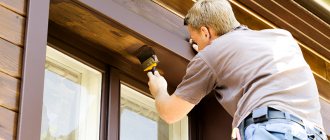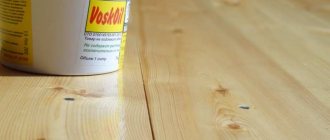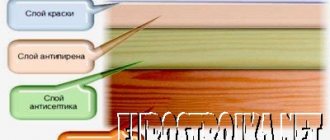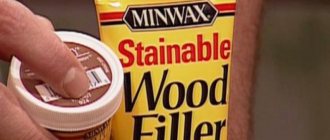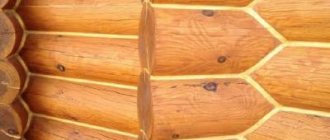Environmental friendliness in the construction of private cottages is gaining increasing popularity. For this reason, wooden facades are no longer uncommon. Everyone knows that wood has a beautiful texture and is at the same time a very difficult material to use. In this article we will tell you how to preserve the strength of natural wood and protect it from the harmful effects of the external environment. Let's figure out why impregnations are required and what paint is best to paint a wooden house. Let us describe the technology for carrying out measures for processing a wooden facade, taking into account previous operation.
What paint is best to paint a wooden house?
Features of wood paint
What are wood paints used for? There are a number of factors that require regular monitoring.
Thanks to special compounds, it is possible to prevent the following phenomena:
- Fiber rotting. High humidity and improper use of a wooden product lead to destruction of the internal structure;
- Oxidation. Temperature changes and humidity provoke deformation inside the tree;
- Drying out. Solar insolation and high air temperatures lead to a reduction in product volumes;
- Discoloration. Ultraviolet rays change decorative qualities and reduce pigment saturation;
- Reproduction of mold and fungi. The absence of antiseptic components in the primer is accompanied by the proliferation of dangerous microorganisms.
Timely painting of wooden products allows you to extend their performance properties. In addition, a catalog of wood paint colors allows you to decide on the shade of the structure.
For work, impregnations and primer mixtures are used, which will help fix the finishing layer. By following an integrated approach, it is possible to achieve high-quality technical features.
What should you protect wood from?
Like any other building and finishing material, wood has two main enemies - ultraviolet radiation and moisture. Under the influence of sunlight, lignin, a substance responsible for density and strength, is destroyed. Consequently:
- wood permeability increases;
- under the influence of UV radiation, the natural color fades;
- a dirty gray tint appears;
- moisture penetrates into deep layers;
- the tree swells, it is “led”;
- mold and other biological lesions appear;
- The service life of wood is reduced.
If we consider wooden interior decoration or massive furniture, then it is influenced by ultraviolet radiation, albeit in smaller quantities, and moisture, and mechanical influences. Unlike plastic and composite, it is almost impossible to completely remove grease or dirt from an untreated wooden surface. In order for the wood to remain in its original form both in the house and on the street for as long as possible, it is necessary to use wood paint or another product, but always a specialized one, to protect it.
What to consider when choosing
Which wood paint to choose for interior work? When selecting a decorative coating, it is recommended to take into account several criteria. They are as follows:
- Type of wood. Each type of wood has its own characteristic features, which appear immediately after staining;
- Exploitation. Each plane inside the room and on the facade of the building is exposed to all kinds of influences. When selecting paints and varnishes, one should take into account humidity, solar insolation, exposure to combustion products, temperature deviations, physical and mechanical deformation;
- Processing the base. For high-quality protection of wood and prolongation of its operational life, the use of primers is recommended. Thanks to them, the protective qualities of the coating are enhanced, ensuring alignment of the absorbent structure;
- Preliminary compositions. It is recommended to select a primer based on the composition of the paintwork. If the material is selected incorrectly, the likelihood of further deformation of the finished coating increases.
Acrylic
This type of paint has absorbed the whole range of advantages: fast drying (no more than 8 hours), special wear resistance, insensitivity to climatic and atmospheric influences, good elasticity, which prevents the formation of cracks after painting, and lack of odor.
The unique properties of this material include vapor permeability, which allows the wood to “breathe”, that is, not to prevent excess moisture from leaving the room through the wooden walls, thus creating an excellent microclimate inside. Acrylic paint is almost an ideal option for wooden buildings.
Types of paint and varnish coatings for wood
To work with a wooden base, use glaze glaze, antiseptic compounds, varnish, water-based impregnation, paint or enamel. Let's look at the advantages and disadvantages of each type of material.
Glaze coating allows you to view the structure of wood fiber. Thanks to these coatings, it is possible to convey the natural color of wooden surfaces and enhance the decorative properties.
- Alkyd and acrylic paints refer to the surrounding compositions. Yes, the production of these paints and varnishes uses various technologies.
- They can consist of an introductory and organic base.
- For example, alkyd and forest dyes are popular and affordable types of finishing materials.
- They are characterized by high performance properties. Acrylic dyes are considered durable and wear-resistant coatings.
- These odorless wood paints can be used for interior and exterior decoration.
- The advantages of these materials are their drying and minimal toxic evaporation.
Finish enamel or alkyd coatings are made using polymer resins. When dried, they form a dense layer that looks like a transparent crust. Thanks to it, resistance to various disasters increases. Alkyd enamel is considered an affordable option.
When applying a thin layer, the moisture resistance of the coating increases. As they dry, they release caustic fumes. Paints based on polyurethane resins have elasticity, as a result of which they resist mechanical deformation. This rubber paint for wood can be used for 10 years.
Comparison table of characteristics
The table below presents the main characteristics of the paints in question for wooden surfaces. By comparing them with each other, it will be easier for the buyer to make a choice and purchase a quality product.
| Paint name | Type of work | A country | Type of paint |
| Tikkurila Miranol | internal | Finland | alkyd enamel |
| Alpina Aqua Buntlack | internal | Germany | acrylic, water-dispersion |
| Adler Lignovit Color | internal | Austria | acrylic |
| Ace Paint Contractor Pro Interior Wall | internal | USA | acrylic |
| Dulux | external | USA | oil-alkyd |
| Zobel | external | Germany | covering |
| Rogneda Aquatex | external | Russia | texture coating |
Requirements for paint and varnish coatings for facades
Which wood paint to choose for exterior work? When selecting, you must consider:
- Compound. No toxic compounds are used to produce these materials. The fact is that during the drying process they release a large volume of flexible compounds;
- Drying speed. Quality products dry within 5 hours after application. Each layer dries on average in 1-3 hours;
High performance. Conscientious manufacturers indicate the density of the paint layer, drying time and approximate service life. In addition, the instructions show favorable areas for the use of a particular composition.
Technology
The whole process takes place in 4 stages. At the same time, scrupulousness and attention are required to complete the work. It is important to do everything carefully, without leaving untreated areas.
Stage 1. Removing the old coating. This procedure is performed if there is an old paint coating. It needs to be removed. To do this, you can use spatulas, a wire brush, sandpaper or a grinder with an attachment. There will be quite a lot of dust, so you should work with glasses and a respirator.
All work is carried out in dry, not hot weather. The entire area of the facade will have to be protected, including the joints of logs or boards. In order for the work to be completed efficiently and without delay, remove the drainage elements, shutters and trim from the facade in advance. In addition to old paint, dust and street dirt should be removed from the facade.
Important! You should not leave old paint on, even if the layer sits firmly on the surface. Its service life will expire and it will peel off along with the new coating.
Before painting the facade, remove the old coating
Stage 2. After the facade is cleared of paint, the wood is sanded and puttied. If there are areas of darkening, or pockets of fungal infection are visible, the top layer of material should be removed to a clean texture. The rest of the surface is leveled. Existing defects on the surface are eliminated by puttying. Before moving on to the next steps, the putty must dry. The putty material must be compatible in composition with impregnation and paint.
The top layer of wood is cleaned and sanded
Stage 3. Deep penetration impregnation is applied to the cleaned wooden surface, the composition of which is selected depending on the characteristics that require strengthening. Typically, impregnation is applied with a wide brush along the grain to preserve and emphasize the natural texture of the wood.
Do not neglect priming; impregnation will not only improve the quality of the wood, but will increase the adhesion of paint to the surface, while reducing the amount of material consumed. Even though wood primers are quite expensive, their use is worthwhile. Before applying the paint, the impregnation must dry; the period for complete drying is indicated by the manufacturer on the packaging.
For longer service life, the wood should be impregnated with certain compounds.
Step 4. Before starting work, check the long-term weather forecast. Rain is not suitable for painting, nor is heat. In addition, work should be carried out during the daytime, when the dew has either already evaporated or has not yet settled, that is, from 10 to 18 hours. The paint is applied in several layers along the fibers. Each subsequent layer should be applied only after the previous one has dried.
To paint a wooden facade, a wide brush is usually used.
Video - Technology of painting a wooden facade
Some nuances of coloring
It would seem that the process is quite simple and transparent. But here, as everywhere else, there are nuances:
- If the facade has external metal fastening elements, then before priming and painting they should be filled with an oil or acrylic compound to match the color of the wood. This work will be especially relevant if the finishing coating is planned to be made transparent.
- If you approach the issue carefully, you can use several impregnating compounds; water-repellent impregnation is applied last.
- For better surface quality, after the impregnation has dried, the wood should be sanded to remove small roughness and lint.
You can improve the quality of a wooden surface by sanding the wood after applying the primer.
What is used for working with wood?
We invite you to familiarize yourself with the common types of paint and varnish coatings for treating wood frames. They are divided into:
- Acrylic compositions. They are enamel based on water-borne components. When in contact with a wooden base, they dry quickly and do not emit caustic compounds;
- Glazing coatings. They are used to emphasize the decorative qualities of wood. In addition, they have excellent protective qualities;
- Covering species. These include oil and acrylic types of paints. They are used to create a thick crust on the surface of the wood;
- Nitrolac. It is used as a decorative coating for wooden frames. The composition is highly flammable. They protect from solar insolation. In what area is it used? It is recommended to choose them for processing wooden parts in the construction of furniture or premises.
Oily
Until recently, this type was perhaps the most widespread. Its composition traditionally includes drying oil as the main ingredient with the addition of mineral dyes and various additives.
This product is well absorbed into the surface and forms a fairly durable coating, but at the same time it takes a very long time to dry (about 2 days).
At the same time, the painted surface is very vulnerable to sunlight and quickly loses its previous appearance. Before use, the solution must be stirred due to the formation of sediment.
Photo of paint for wood
Tool selection
To paint wood with enamel you will need a minimum number of tools, necessary materials and special technologies for its use. Before carrying out painting work, you must stock up on a brush or roller with which you will paint the working surface. Instead of a roller, you can use a spray bottle. It is worth noting that using a spray gun allows you to reduce paint consumption and apply it in a more uniform layer when painting a surface.
In addition, for painting work you will need personal protective equipment and sandpaper. To clean the surface to be painted, you can use a special sanding wheel instead of sandpaper. Gloves, protective transparent glasses, as well as a respirator or a special filter are used as personal protective equipment.
